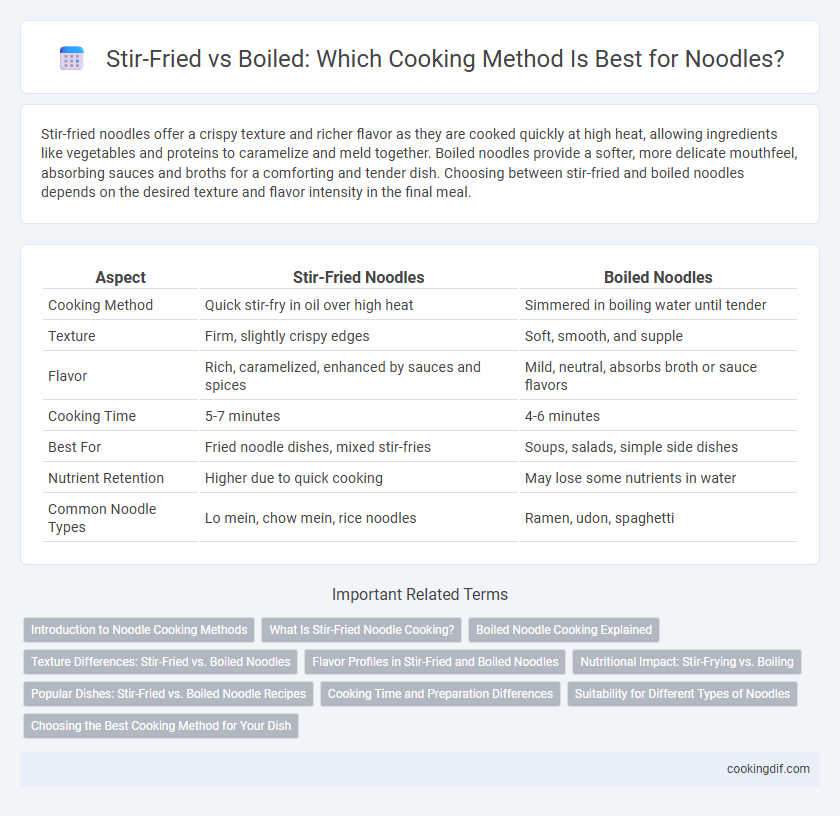Stir-fried noodles offer a crispy texture and richer flavor as they are cooked quickly at high heat, allowing ingredients like vegetables and proteins to caramelize and meld together. Boiled noodles provide a softer, more delicate mouthfeel, absorbing sauces and broths for a comforting and tender dish. Choosing between stir-fried and boiled noodles depends on the desired texture and flavor intensity in the final meal.
Table of Comparison
| Aspect | Stir-Fried Noodles | Boiled Noodles |
|---|---|---|
| Cooking Method | Quick stir-fry in oil over high heat | Simmered in boiling water until tender |
| Texture | Firm, slightly crispy edges | Soft, smooth, and supple |
| Flavor | Rich, caramelized, enhanced by sauces and spices | Mild, neutral, absorbs broth or sauce flavors |
| Cooking Time | 5-7 minutes | 4-6 minutes |
| Best For | Fried noodle dishes, mixed stir-fries | Soups, salads, simple side dishes |
| Nutrient Retention | Higher due to quick cooking | May lose some nutrients in water |
| Common Noodle Types | Lo mein, chow mein, rice noodles | Ramen, udon, spaghetti |
Introduction to Noodle Cooking Methods
Stir-fried noodles involve quickly cooking noodles in a hot wok or frying pan with oil, vegetables, and proteins, developing a rich, caramelized flavor and slightly crispy texture. Boiled noodles are cooked in boiling water until tender, preserving their soft, chewy consistency and making them versatile for soups and salads. Both methods highlight different textures and flavors, essential for mastering diverse noodle dishes in Asian and global cuisines.
What Is Stir-Fried Noodle Cooking?
Stir-fried noodle cooking involves quickly frying pre-cooked or soaked noodles in a hot wok with oil, combined with vegetables, proteins, and flavorful sauces to create a savory and textured dish. This method enhances the noodles' taste through caramelization and allows ingredients to retain a slight crunch, contrasting with the soft texture from boiling. Stir-frying is popular in Asian cuisine for its ability to blend flavors efficiently while maintaining distinct ingredient textures.
Boiled Noodle Cooking Explained
Boiled noodle cooking involves submerging noodles in boiling water until they reach the desired texture, typically al dente, which preserves their firmness and chewiness. This method allows noodles to absorb water evenly, resulting in a tender, smooth texture that pairs well with sauces and broths. Boiling also prevents the noodles from sticking together, ensuring a uniform cooking process that enhances the overall dish quality.
Texture Differences: Stir-Fried vs. Boiled Noodles
Stir-fried noodles develop a firmer, slightly crispy texture due to direct contact with high heat and oil, enhancing their chewiness and flavor absorption. Boiled noodles retain a softer, more uniform texture characterized by tenderness and moisture retention, which makes them ideal for soups and lighter dishes. The choice between stir-frying and boiling fundamentally alters the noodle's mouthfeel and suitability for different culinary styles.
Flavor Profiles in Stir-Fried and Boiled Noodles
Stir-fried noodles develop a rich, smoky flavor due to the Maillard reaction, often enhanced by soy sauce, garlic, and sesame oil, creating a complex and savory taste. Boiled noodles offer a milder, cleaner palate that highlights the natural wheat or rice flavors, making them ideal for absorbing broths and lighter sauces. The textural contrast also influences flavor perception, with stir-fried noodles often crispier and boiled noodles tender and slippery.
Nutritional Impact: Stir-Frying vs. Boiling
Stir-frying noodles preserves more nutrients such as vitamins B and C by using high heat for a short time, minimizing nutrient loss compared to boiling. Boiling noodles can cause water-soluble vitamins and minerals to leach into the cooking water, reducing the overall nutritional value. Choosing stir-frying enhances nutrient retention and adds beneficial antioxidants from added vegetables and oils.
Popular Dishes: Stir-Fried vs. Boiled Noodle Recipes
Stir-fried noodles like Pad Thai and Chow Mein feature a savory mix of vegetables, proteins, and sauces that enhance texture and flavor through high-heat cooking. Boiled noodles commonly appear in dishes such as Ramen and Pho, where the noodles absorb rich broths and pair with tender meats and fresh herbs for a comforting meal. Both methods highlight the versatility of noodles by offering distinct taste profiles and culinary experiences.
Cooking Time and Preparation Differences
Stir-fried noodles typically require less cooking time than boiled noodles, as the quick high-heat method rapidly cooks thin noodle strands while simultaneously sauteing vegetables and proteins. Boiled noodles need more preparation time, involving boiling water and cooking noodles until soft, usually between 3 to 7 minutes depending on the noodle type. Stir-frying demands active attention with continuous stirring to prevent sticking, whereas boiling is more passive, allowing noodles to cook evenly submerged in water.
Suitability for Different Types of Noodles
Stir-frying is ideal for flat, wide noodles like chow fun or lo mein, as the high heat enhances their texture and allows them to absorb bold sauces effectively. Boiling suits delicate noodles such as rice vermicelli or thin egg noodles, preserving their softness and preventing breakage. Choosing the cooking method based on noodle type ensures optimal flavor and texture in dishes.
Choosing the Best Cooking Method for Your Dish
Stir-frying noodles preserves a chewy texture and enhances flavor through caramelization, making it ideal for dishes requiring bold, savory profiles. Boiling noodles ensures even cooking and softness, perfect for soups or delicate recipes needing smooth, tender strands. Selecting the cooking method depends on the desired texture and flavor intensity tailored to your specific noodle dish.
stir-fried vs boiled for cooking method Infographic

 cookingdif.com
cookingdif.com